|
The "Lost Tombs" Revisited:
"Success Has a Thousand Fathers ..."
Part III
So, what are these peculiar "signs at Abydos" -- just "tricks of
fallen plaster" according to the Egyptologists -- actually trying to
tell us? Hieroglyphs are supposed to be a written language, so what
do they literally say ..?
According to one expert, the "Abydos Glyphs" actually translate to--
"... It was decided in antiquity to replace the five-fold royal
titulary of Seti I with that of his son and successor, Ramesses II.
In the photos, we clearly see "Who repulses the Nine Bows," which
figures in some of the Two-Ladies names of Seti I, replaced by "Who
protects Egypt and overthrows the foreign countries," a Two-Ladies
name of Ramesses II. With some of the plaster that once covered Seti
Iís titulary now fallen away, certain of the superimposed signs do
indeed look like a submarine, etc., but itís just a coincidence ...
"... In the term "...the Nine Bows..." This does NOT refer to
"salute" (as in "Neufs Saluts"), but "bows" as in archery....sort of
"líarc du tir ż líarc" (I am using a translation program here, so I
hope this becomes clear...;\ ) The "Nine Bows" refers to the
'nine
traditional enemies of Egypt', so an alternate (though not literal)
translation of the phrase is: "Who repulses the Nine [Enemies of
Egypt]" [emphasis added] ..."
Again, warmest regards --
Katherine Griffis-Greenberg
Member, American Research Center in Egypt,
International Association of Egyptologists
University of Alabama at Birmingham
Special Studies
http://www.griffis-consulting.com/
Apparently lost on everyone was the small matter of another
remarkable "coincidence" represented by these Glyphs ...
their
precise translation ...
If the actual text (in the "over written" hieroglyphic model) indeed
says something even close to what Katherine Griffis-Greenberg says
it does "[Ramses II] ... Who repulses the Nine [Enemies of Egypt]
..." -- isnít it remarkable that the old/new hieroglyphic symbols
making up that particular text--
Just by "chance" ... happen to look exactly like a series of modern
war machines -- that any Pharaoh would have given half of Egypt
for... to "repulse the Enemies of Egypt!?"
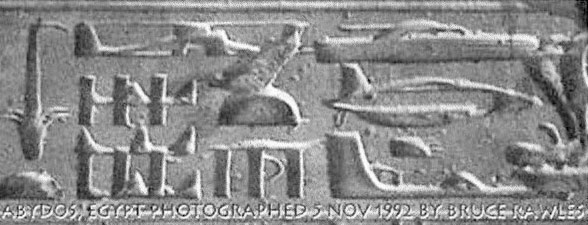
In a black & white, higher-resolution, non-doctored version of the
same Abydos panel (taken by another tourist, Bruce Rawles, in 1992
-- above), this extraordinary (and I would bet, heretofore
unrecognized) "self-referential coincidence" -- represented by this
Ramses II "titulary translation" -- is even more apparent:
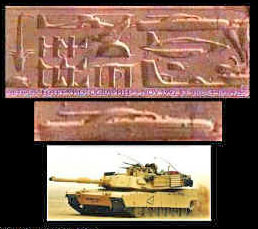 A panel whose directive specifically refers to keeping out
("repulsing") the traditional enemies of Egypt ("the Nine Bows") --
and then features the astonishing depiction of at least four
artistically-precise, instantly recognizable war machines of the
20th century
(click image right)
fully capable of accomplishing the task: A panel whose directive specifically refers to keeping out
("repulsing") the traditional enemies of Egypt ("the Nine Bows") --
and then features the astonishing depiction of at least four
artistically-precise, instantly recognizable war machines of the
20th century
(click image right)
fully capable of accomplishing the task:
the infamous
"helicopter" (top left) ... an unmistakable "tank," complete with
gun barrel (top right -- and, see also color M1A1 "Abrahms"
comparison, below) ... a sleek "jet fighter" (middle right) ... and
something looking suspiciously like LukeíŪs anti-gravity "land
speeder," right out of "Star Wars" (bottom right).
The Egyptological argument -- that we are merely seeing "random,
fallen plaster ..." creating this illusion in our minds -- is simply
untenable at this point, not only because of this incredible
linguistic "coincidence" -- but because of another statistical
impossibility as well:
Weíre not just seeing one "illusion" here ... weíve got at least
four ... four very sophisticated representations of four different
types of the same "impossible" technology (20th/21st Century war
craft) -- all grouped together on one panel.
The granddaddy of all "statistical improbabilities!"
In my opinion, if this all can be dismissed as "mere coincidence" --
then the Pyramids themselves (by this reasoning) must be "merely"
the product of a freak Saharan sandstorm!
Finally, there is one last feature apparently first noticed by the
owner of
another Website, also presenting the "mysteries of Abydos":
Lumir G. Janku. Even though he ultimately takes the point of view of
the majority of Egyptologists -- that the glyphs are nothing more
than "tricks of light and plaster" -- Janku himself seems troubled
by one "niggling" detail...
"There is one aspect of the inscription which is puzzling. The
temple in Abydos (or Abdjou, as the location was called by
Egyptians), is quite a remarkable edifice, especially as far as the
quality of glyphs is concerned. They are all very precise and as far
as I can judge, thereís no trace of sloppy workmanship anywhere in
the temple, bare the above inscription. The temple was build by Seti
I and finished by his son, Ramses II, during an era of classical
revival. The obvious corrections on the inscription in question are
thus seemingly out of place ...
One of the Egyptologists, in responding to the French inquiries,
makes passing mention of the central "problem" in all this--
" ... why is Abydos the ONLY place where they are supposedly
represented? NO archaeological evidence has been found to support
the existence of any of these items [elsewhere] in ancient Egypt.
This includes evidence of helicopters, computers, etc., in tomb
paintings ..."
The answer is: heís wrong!
First -- I would like to thank Peter Uwira, in Austria, for some of
the following, remarkable information ...
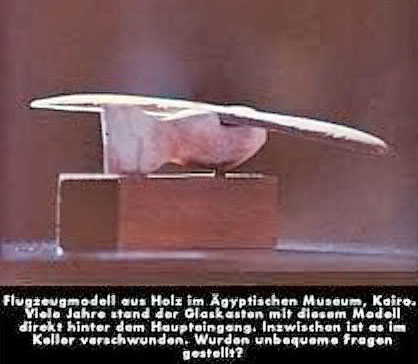
Because ... in 1898, in
a tomb at Saqqara (located about 40 miles
south of the Giza Plateau), a curious physical object was discovered
(see photo --
above). It baffled the archaeologists who found it,
who could only approximate the date of its internment (before
radiocarbon techniques), as "about 200 BC." As the Wright Brotherís
public experiments in "heavier-than-air" flight were still almost a
decade away, there was no general comprehension as to the potential
nature of this object. So, it was labeled "wooden bird model," and
routinely relegated (like a lot of other stuff!) to the basement of
the most famous Egyptological Museum in the world, in downtown
Cairo.
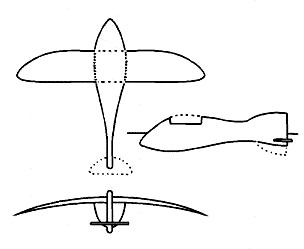 Three quarters of a century later, in 1969, a famed Egyptian --
Dr. Khalil Messiha, chanced upon the model ... still in its dusty box in
the Cairo Museum basement. His preliminary analysis -- that, this
could be a model of an ancient aircraft! -- so electrified the
Egyptian government, that a special panel of "distinguished
scientists" was convened study this one object. Their conclusion:
that the model incorporated some extremely sophisticated aerodynamic
features (such as "a reverse dihedral wing ..." similar to several
modern aircraft" --
see drawings, left). Three quarters of a century later, in 1969, a famed Egyptian --
Dr. Khalil Messiha, chanced upon the model ... still in its dusty box in
the Cairo Museum basement. His preliminary analysis -- that, this
could be a model of an ancient aircraft! -- so electrified the
Egyptian government, that a special panel of "distinguished
scientists" was convened study this one object. Their conclusion:
that the model incorporated some extremely sophisticated aerodynamic
features (such as "a reverse dihedral wing ..." similar to several
modern aircraft" --
see drawings, left).
Based on the results of this remarkable, official study, it was
decided to set up that Summer -- the Summer of the First Apollo
Landing on the Moon! -- a Special Exhibit in the Museum on the
entire subject (contrast this response to that of the current
generation of Egyptologists, including Hawass, and their continually
dismissive reaction to anything "anomalous" -- including, the
mysterious "glyphs at Abydos" ...).
The location of the Exhibit: the most prominent place in the entire
Museum, in the coveted Central Hall itself.
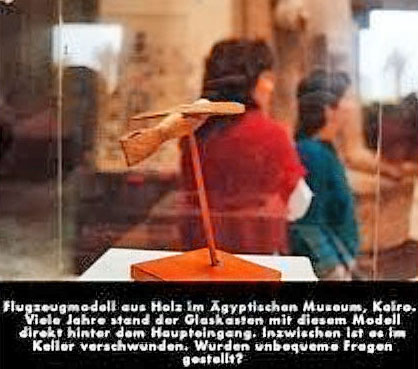
So, the little model (in its own glass case -- see
above) became the
centerpiece of the Exhibit ... if not the entire Museum (for awhile
...) It was even clearly labeled: "ancient model airplane!"
Then, recently ... it vanished. Just like that. And no one seems to
be able now to find it -- or, the official Egyptological Committee
Study which brought it to such prominence ...
Now, why do you suppose that is? (Obviously ... this is another job
for Fox!)
But thatís not all ...
A quarter of the way around the world, over the last hundred or so
years, other archaeologists have repeatedly found small trinkets
they term "insects," buried with their former owners in a variety of
Central and South American tombs. In truth, the objects far more
resemble the wooden Egyptian model found at Saqqara (!) -- though
they are significantly smaller and, of course, are made not of wood,
but of precious metals -- primarily gold.
Which meant that they were sacred objects -- possibly connected with
"the gods."
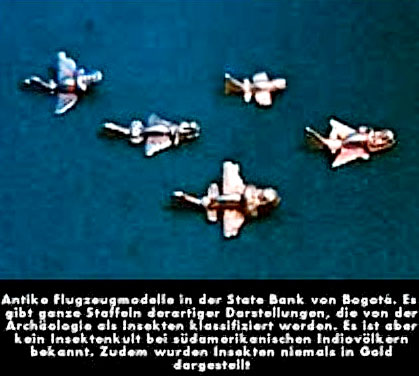
As near as one can reconstruct the history, it was
Erich von Daniken
-- author of the 70ís best seller, "Chariots of the Gods?" -- who
first suggested that these "gold insects" (some with delta-shaped
wings --
see image, above) didnít resemble true insects at all; I
mean, what insects come with an unmistakable vertical stabilizer?!
These "insects," in fact, do look far more like some kind of
manufactured, technological artifacts -- like, in fact, "miniature
jet fighters!" -- than anything from the zoological kingdom here on
Earth.
Not satisfied with archaeological conclusions (or speculations)
based on mere "appearance," several years ago two German
scientists/engineers familiar with von Danikenís decades-old
suggestion -- Dr. Algund Eeboom and Mr. Peter Belting -- decided to
approach the problem from complimentary directions: statistical
research and aeronautical engineering.
Eeboom began a comparative historical/archaeological assessment:
comparing all known
copies of the Central and South American
"insects" found in the tombs, with the biology and morphology of
real insects. And he discovered that most of the trinkets were, in
fact, insects -- with the distinguishing characteristic that, in the
models, their wings (like the real thing!) were joined to the body
on top.
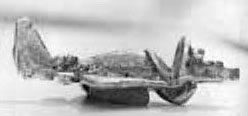 The "plane-looking" artifacts (the ones with the inevitable vertical
stabilizer), by contrast, distinguished themselves by having their
wings attached on the bottom of "the craft"
(see close-up, left). The "plane-looking" artifacts (the ones with the inevitable vertical
stabilizer), by contrast, distinguished themselves by having their
wings attached on the bottom of "the craft"
(see close-up, left).
Thus, the ancient cultures Eeboom studied, demonstrably knew (and
could skillfully model) their bonafide insects "true to life" ... as
opposed to the handful of technological-looking "artifacts" that had
also been discovered.
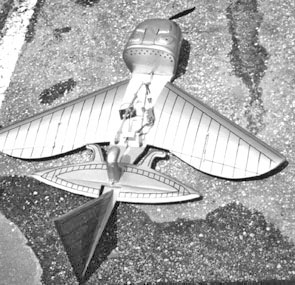 The conclusion, according to Eeboomís impressive statistics: the
ancient craftsmen really meant for their miniature "airplanes" to
look like ... airplanes! The conclusion, according to Eeboomís impressive statistics: the
ancient craftsmen really meant for their miniature "airplanes" to
look like ... airplanes!
Peter Belting approached the problem from a "hands on" point
of view: he actually built scaled-up (but otherwise precise) models
of the ostensibly "miniature aircraft" (image, below left) -- and
then attached propellers and jet engines (image right).
And they flew!!
At the August, 1997 meeting of the " Ancient Astronaut Society World
Conference," gathered in Orlando, Florida, the two researchers
presented their independent findings on the "insects." Those
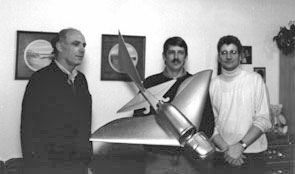 assembled literally cheered when
Beltingís model (powered by a small
jet engine -- right) successfully took off on video ... flew a set of
complex aerodynamic maneuvers ... and then came in for a perfect
landing -- all with a model airplane built as an exact match to a
tiny gold trinket found in an Incan grave ... dated minimally to
over a thousand years ago! assembled literally cheered when
Beltingís model (powered by a small
jet engine -- right) successfully took off on video ... flew a set of
complex aerodynamic maneuvers ... and then came in for a perfect
landing -- all with a model airplane built as an exact match to a
tiny gold trinket found in an Incan grave ... dated minimally to
over a thousand years ago!
Then, in case anyone still doubted, Belting and Eeboom took everyone
out into the parking lot of the Orlando Florida Mall (note the light
pole, below!) ... and once again, put the "thousand-year-old" (if
not far older ...) jet-powered aircraft through its paces for the
astonished crowd -- this time, live ...
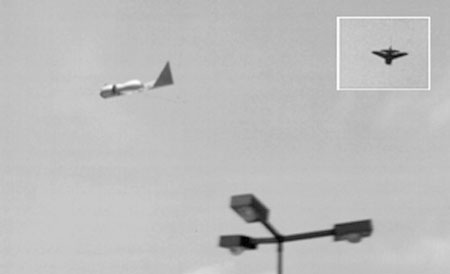
(Continued in Part IV)
|



 Three quarters of a century later, in 1969, a famed Egyptian --
Three quarters of a century later, in 1969, a famed Egyptian --


 The "plane-looking" artifacts (the ones with the inevitable vertical
stabilizer), by contrast, distinguished themselves by having their
wings attached on the bottom of "the craft"
(see close-up, left).
The "plane-looking" artifacts (the ones with the inevitable vertical
stabilizer), by contrast, distinguished themselves by having their
wings attached on the bottom of "the craft"
(see close-up, left). The conclusion, according to Eeboomís impressive statistics: the
ancient craftsmen really meant for their miniature "airplanes" to
look like ... airplanes!
The conclusion, according to Eeboomís impressive statistics: the
ancient craftsmen really meant for their miniature "airplanes" to
look like ... airplanes! assembled literally cheered when
Beltingís model (powered by a small
jet engine -- right) successfully took off on video ... flew a set of
complex aerodynamic maneuvers ... and then came in for a perfect
landing -- all with a model airplane built as an exact match to a
tiny gold trinket found in an Incan grave ... dated minimally to
over a thousand years ago!
assembled literally cheered when
Beltingís model (powered by a small
jet engine -- right) successfully took off on video ... flew a set of
complex aerodynamic maneuvers ... and then came in for a perfect
landing -- all with a model airplane built as an exact match to a
tiny gold trinket found in an Incan grave ... dated minimally to
over a thousand years ago!